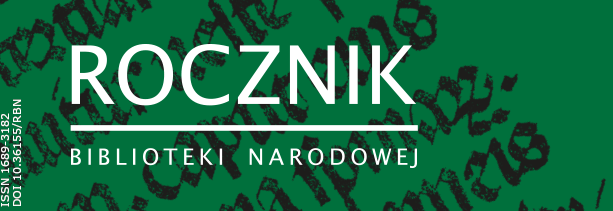O CZASOPIŚMIE
„Rocznik Biblioteki Narodowej" jest periodykiem naukowym poświęconym szeroko rozumianej kulturze piśmiennej (a także wybranym zagadnieniom historyczno-artystycznym, ikonograficznym i muzykologicznym) oraz jej funkcjonowaniu zarówno w perspektywie historycznej, jak współczesności. Tematyka materiałów zawartych w „Roczniku BN" dotyczy przede wszystkim bibliologii, bibliotekoznawstwa, historii wraz z naukami pomocniczymi, historii sztuki, muzykologii, edytorstwa i prasoznawstwa.
Czasopismo znajduje się na liście czasopism naukowych Ministerstwa Edukacji i Nauki z liczbą 40 punktów.
NUMER BIEŻĄCY

STRONA REDAKCYJNA, SPIS TREŚCI, s. 1–10 / CREDITS, TABLE OF CONTENTS, p. 1–10
STUDIA I MATERIAŁY / STUDIES AND MATERIALS
Polski kanon szkolny w gimnazjach rządowych Kraju Nadwiślańskiego (1864–1897), s. 11–33 / Polish school canon of secondary schools (gymnasia) of Vistula Land (1864–1897), p. 11–33
The article aims to explore how the concept of the school canon evolved after 1864 in comparison to the reading recommendations issued by educational authorities in the Polish territories between 1795 and 1863. Following the fall of
the January Uprising, the school canon was primarily transmitted to high school students through textbooks approved by the Warsaw educational authorities. Among these were Wypisy szkolne by Jan Łukomski (in use from 1864 to 1870), Wypisy polskie dla ćwiczenia się w przekładach z języka polskiego na ruski by Piotr Dubrowski (1871–1897), and, starting in 1884, Польская христоматия (Polish Chrestomathy) by Teodor Wierzbowski. An analysis of these textbooks – focusing on the selection of literary texts, including religious, Enlightenment, and Romantic literature; the interpretation of Polish identity and its relationship (or lack thereof) with Russian identity; and the representation of lieux de mémoire significant to Polish national identity – highlights the existence of various models for conceptualizing the school canon in secondary education within the Kingdom of Poland. These findings underscore the tensions between the authorities of the Warsaw Educational District and Polish society.„Książkobójstwo”. W osiemdziesiątą rocznicę zagłady stołecznych bibliotek, s. 35–53 / “Libricide”. On the 80th anniversary of the destruction of Warsaw's libraries, p. 35–53
The author examines the systematic destruction of Warsaw’s libraries during and after the suppression of the Warsaw Uprising (August 1944 – January 1945), situating this devastation within the broader context of Nazi occupation policies
in Poland. The article reveals the calculated obliteration of Polish cultural heritage as a deliberate strategy to erase Poland’s intellectual and historical identity. Beginning with the bombings of 1939, which caused significant damage to numerous libraries, the text traces the intensifying destruction, including the targeted incineration of major institutions such as the Krasiński and Zamoyski Libraries, along with extensive looting by German forces. Testimonies from cultural figures, including Bohdan Korzeniowski and Tadeusz Makowiecki, convey the profound anguish over these irreplaceable losses. The author emphasizes that this libricide represented an unprecedented act of cultural extermination, aimed not only at controlling Poland’s political landscape but at extinguishing its very essence.O klasyfikacji rękopisów muzycznych w Archiwum Henryka Mikołaja Góreckiego, s. 55–76 / Classification of music manuscripts in Henryk Mikołaj Górecki Archive, p. 55–76
The article is an extension clarifying the rules of classification of music manu-scripts of Henryk Mikołaj Górecki, published in Katalog rękopisów Biblioteki Narodowej, t. 27, Archiwum Henryka Mikołaja Góreckiego. Sygnatury 14663–14847, Warszawa 2021. The entry analyses taxonomical solutions in selected catalogues of Polish composers, including Chopin and Szymanowski, as well as foreign ones. Further on, there’s an analysis of the problem of individual classification of Gorecki manuscripts. The article presents the criteria of categorisation of entries and a fundamental, functional differentiation of autographs into drafts, rough graphs and clean drafts, explaining them group by group using selected examples.
Dopuszczalność udostępniania utworów nierozpowszechnionych za pośrednictwem terminali zlokalizowanych na terenie bibliotek i innych instytucji dziedzictwa kulturowego, s. 77–110 / Admissibility of making unpublished works publicly available by terminals located on the premises of libraries and other national heritage institutions, p. 77–110
The Act on Copyright and Related makes it possible for libraries and other institutions of national heritage to make pieces of art available to the public using terminals located on such institutions premises. This right is extensively used by the National Library and entities co-operating with it within the scope of the Digital Library of Scientific Publications Academica. When it comes to property copyrights, there is no doubt that such exploration based on proper public use of pieces of art of non-extinct rights, especially the ones belonging to the public domain. However, the issue should be regarded differently when it comes to personal rights of the author, especially the right of personal decision to make a piece of art available to the public. A question arises whether the group of collections which libraries may make publicly available through local terminals encompasses unpublished media – the ones towards which the personal right was not applied. The article aims to present argumentation supporting different views on the subject and to evaluate their viability.
Organizacja księgozbiorów podręcznych. Opracowanie modelu oznaczeń grzbietowych dla Biblioteki Narodowej w Warszawie, s. 111–132 / Managing reference book collections. Developing a model for call number labels for the National Library in Warsaw, p. 111–132
Library classification systems are used in various ways to organize the reference book collections of national libraries. The article contains conclusions from a review of publicly available information on methods used in national libraries and their closest equivalents in the world. The research and available literature on the subject were used to create a model for call number labels for the National Library in Warsaw (design phase).
RECENZJE I SPRAWOZDANIA / REVIEWS AND REPORTS
Michał Czerenkiewicz, Oficyna Schedlów Schedlów. W świecie drukowanej książki XVII i początków XVIII wieku, Kraków, Wydawnictwo Uniwersytetu Jagiellońskiego, 2023 s. 135–146 / Review of: Michał Czerenkiewicz, Oficyna Schedlów Schedlów. W świecie drukowanej książki XVII i początków XVIII wieku, Kraków, Wydawnictwo Uniwersytetu Jagiellońskiego, 2023, p. 135–146
Literary canon formation as nation-building in Central Europe and the Baltics. 19th to early 20th century, ed. by Aistė Kučinskienė, Viktorija Šeina, and Brigita Speičytė, Leiden – Boston 2021, s. 147–154 / Review of: Literary canon formation as nation-building in Central Europe and the Baltics. 19th to early 20th century, ed. by Aistė Kučinskienė, Viktorija Šeina, and Brigita Speičytė, Leiden – Boston 2021, p. 147–154
Regina Dehnel, Übernommen, weiterverteilt, zerstreut. Die Zentralstelle für wissenschaftliche Altbestände und NS-Raubgut nach 1945, unter Verwendung von Vorarbeiten von Hannah Neumann, mit einem Geleitwort von Achim Bonte, Frankfurt am Main 2024, s. 155–159 / Review of: Regina Dehnel, Übernommen, weiterverteilt, zerstreut. Die Zentralstelle für wissenschaftliche Altbestände und NS-Raubgut nach 1945, unter Verwendung von Vorarbeiten von Hannah Neumann, mit einem Geleitwort von Achim Bonte, Frankfurt am Main 2024, p. 155–159

